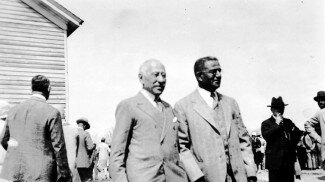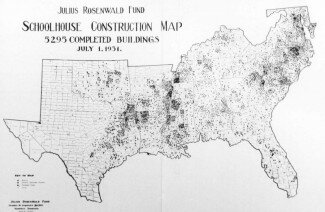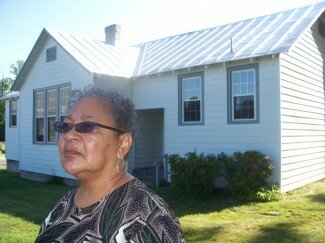Rosenwald revival: Restored elementary school preps reunion
The architectural restoration isn't quite complete, but an upcoming alumni reunion for a long-closed school is already evoking memories as well as opening a window on Albemarle's segregated past.
"There’s a lot of history here, and it’s important to know where you come from,” says 63-year old Rebecca Kinney, one of the last students to attend tiny St. John Elementary, located in the eastern Albemarle village of Cobham.
Kinney recalls a school day that starkly contrasts with today. Kids would arrive early to help stoke the fire, and with no central plumbing, the children used outhouses located behind the school.
 Philanthropist Julius Rosenwald (left) visits the 4000th school he helped build.
Philanthropist Julius Rosenwald (left) visits the 4000th school he helped build.Albert and Shirley Small Special Collections Library, UVA Library
Kinney recalls one teacher presiding over the school's single class of ten, with students ranging from first to fifth grade. Most of the textbooks– and even its bus– were passed down from other area schools.
The little clapboard building is a survivor of what were once an array of over 5,000 so-called "Rosenwald Schools" and related buildings, a massive public-private partnership to upgrade education for African American children in the Jim Crow South.
The structures– 381 of which were built in Virginia– were the brainchild of Sears, Roebuck & Co. chair Julius Rosenwald, who provided funding, as well as famed black educator and Tuskegee Institute president Booker T. Washington, who mustered the skills of Institute architects for the multi-year project.
Though small, the little schools were built to precise architectural specifications. Emphasizing a need for light, large windows became a Rosenwald Schools hallmark, and many of the buildings doubled as community meeting places.
According to a Fisk University database, St. John Elementary was built in 1922 for a cost of $2,500, using contributions from community blacks and whites in addition to funds contributed by Rosenwald and Albemarle County. The school, whose land was owned by Albemarle, closed its doors in 1954 a few years before the County finally desegregated its schools, and was sold as a private home.
 Dots on a map show the breadth of Rosenwald's vision across the South.
Dots on a map show the breadth of Rosenwald's vision across the South.University of Chicago Library Special Collections Research Center
In 2003, however, nearby St. John Baptist Church purchased the property as a part of an effort to construct a new sanctuary. Kinney and other members of the congregation spearheaded a drive to preserve and renovate the schoolhouse. With the exterior mostly complete, the building now carries a luster not seen in at least 50 years.
The next step is renovating the building’s interior, as the church weighs options on the long-term use of the former school, which include creating a senior center. For now, Kinney is focusing on the reunion.
“This is going to bring a lot of those people I haven’t seen back together again,” says Kinney, whose role as a committee chair involved searching for alumni. She ended finding dozens spread out around Virginia as well as other states including Connecticut, New York, and Maryland. She believes 40 to 45 alumni will attend the reunion, with the oldest at age 96.
An important aspect of the reunion will be the collection of oral histories by Albemarle County Historic Preservation Committee members Sara Lee Barnes and Lynn Rainville. The latter, the director of the regional history-focused Tusculum Institute of Sweet Briar College, Rainville praises the church's decision to preserve history.
"This is a remarkable testament to the struggle of people against oppression,” Rainville says.
~
The July 11 reunion starts at 1pm at the schoolhouse, located on St. John Road next to the St. John Baptist Church in Cobham.
[Due to an editing error of mine, the original version of this story suggested that St. John closed "when" Albemarle desegregated its schools. In actuality, it closed "a few years before" Albemarle desegregated. Although some parents may have sought integration in 1954, the year of the famous Brown v. Board decision and the year that St. John closed, Albemarle didn't start integrating its schools until 1959.–Hawes Spencer, Editor]

5 comments
"The school, whose land was owned by Albemarle, closed its doors in 1954 when the County finally desegregated its schools..." Are you certain that desegregation occurred in the County in 1954?
Good point, Cville Eye. I did my young reporter wrong and edited an error into his story. Please see my correction appended above to the end of the story.--hawes spencer, editor
A tribute to all those involved in saving this invaluable piece of America's history and bringing this to our attention. We are blessed to have the Hook so this wonderful story could reach a wider community. Don't miss the fascinating article at the link ( Rosenwald Schoools ) above. Rosenwald is an inspiration for stimulating this movement, but even more moving are the African American's who gave as well to fund and build these schools.
" one fundraising rally, an old man who had been a slave offered his life savings of $38 "to see the children of my grandchildren have a chance."
Interesting article. Thanks for sharing!
Thank you Cville Eye, Rob Schilling is the community watchdog on the radio and you are the community watchdog of the blogosphere. I appreciate all your insight and knowledge.